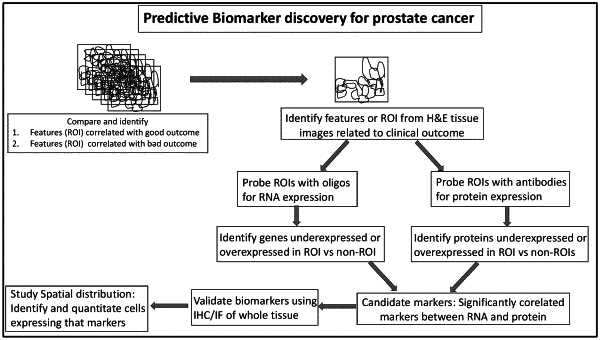| CPC G16B 20/20 (2019.02) [G06N 5/04 (2013.01); G06N 20/00 (2019.01); G06T 7/0012 (2013.01); G06T 7/11 (2017.01); G16B 20/10 (2019.02); G16B 40/30 (2019.02); G16H 10/40 (2018.01); G16H 30/40 (2018.01); G16H 50/20 (2018.01); A61B 10/0041 (2013.01); G06T 2207/20081 (2013.01); G06T 2207/30024 (2013.01); G06T 2207/30096 (2013.01); G06T 2207/30204 (2013.01)] | 22 Claims |

|
1. A computer-implemented method of directly predicting molecular changes in one or more disease tissue sections from a subject, the method comprising:
analyzing molecular markers, which are predictive of tumor response and have no defined correlation with morphological features, such that the method is carried out in unsupervised manner; and
using artificial intelligence to correlate morphometric changes with critical gene modifications and molecular changes, wherein using the artificial intelligence comprises:
(i) collecting whole-slide images (WSIs) of tissue sections obtained from the subject;
(ii) feature extracting the whole-slide images into patches and corresponding vectors to generate clusters of vectors with morphologically similar patterns;
(iii) sampling the patches uniformly across each cluster to generate a batch of vectors that represent the subject's images;
(iv) generating a score between 0 and 1 for each patch based on gene status; and
(v) generating an outcome morphometric score for the subject by combining selected patches;
(vi) identifying regions of interest (ROIs) corresponding to morphological features correlated with disease outcome;
(vii) probe the ROIs with genes and protein specific probes;
(viii) identifying and quantifying RNA and proteins expressed in regions of interest (ROIs);
(ix) performing a correlation analysis between the RNA and the proteins expressed in the ROIs; and
(x) identifying biomarkers in the ROIs based on their expression or non-expression in other tissues, thereby identifying ROIs that are predictive of disease outcome.
|